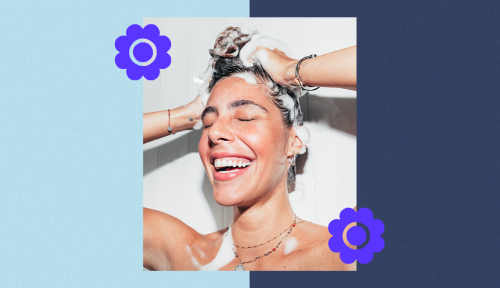My dandruff often feels like an annoying ex-boyfriend I can’t seem to get rid of. I’ve tried everything in my power to ditch it—kitchen-chemistry TikTok hacks, pricey new shampoos, a very expensive shower filter—but just when I think it’s gone, it comes back begging for attention.
What’s worse, my scalp can go from squeaky clean to covered in flakes seemingly overnight. This unwanted buildup usually happens as a result of stress or extreme temperature changes, which happen to be two of the main causes of dandruff, according to Marisa Garshick, MD, a board-certified dermatologist based in New York.
“[Dandruff] is thought to relate to inflammation and yeast occurring in sebum-rich areas of the body,” Dr. Garshick says. “While it can occur at any time, it can be exacerbated by stress. [What’s more,] it may impact people differently during the different seasons, with some people noticing a worsening in the winter months and an improvement in the summer months. It is thought that the cold, dry winter air can be harsh on the skin barrier and predisposes to a worsening and more inflammation in the winter months.”
So unless I want to relocate to some sort of yoga retreat in Florida, these triggers are pretty much unavoidable. What is avoidable, though, is how they show up on my scalp. According to Dr. Garshick, with the right products and practices (which, apparently, are not the ones I’ve tried in the past), it’s entirely possible to get rid of the itching and flaking once and for all.
So for one week, I put her dandruff-fighting tips into action (spoiler: they involved ditching my pricey shampoo and picking up Head & Shoulders from CVS) for my very own derm-approved “scalp bootcamp.” Keep reading to see how it went.
Dr. Garshick’s top 3 dandruff-fighting tips:
1. Use the right products
The first step in successfully staving off dandruff is to find the right product. “While some people may find their dandruff improves just by washing their hair more frequently, it can also help to use a shampoo with key ingredients to target dandruff including anti-fungals such as zinc pyrithione, selenium sulfide, and ketoconazole, or keratolytics to help with the build up of dead skin such as salicylic acid,” Dr. Garshick says.
Since I have dry, curly, color-treated hair, and in the past have found many dandruff solutions too drying for my strands, Dr. Garshick suggested Head & Shoulders Smooth and Silky Shampoo, “which contains pyrithione zinc to help reduce flaking,* while still keeping the hair and scalp moisturized.”
For maximum flake-fighting powers, Dr. Garshick recommends pairing the shampoo with Head & Shoulders’ complimentary Smooth and Silky Conditioner, which “offers a great additional option as it helps to condition the hair and scalp, in addition to controlling frizz, while also protecting against dandruff,” she says. “Finding products that not only contain the active dandruff-fighting ingredients like zinc pyrithione, but also nourishing ingredients such as almond oil, [help] keep the scalp feeling healthy.” Check and check.
2. Wash properly and frequently
Once I had the right ingredients lined up, Dr. Garshick advised me to keep one more thing in mind in an effort to tackle my flaky scalp without totally drying out my hair: the way I wash my hair is important, too. “When trying to treat dandruff, it is most important to apply the shampoo to the scalp, not necessarily the strands of hair,” says Dr. Garshick, who recommends concentrating the shampoo on your scalp. One easy way to do this? Try wetting your hair then flipping your head over and applying your shampoo upside down, which will allow you to really scrub your scalp and the oft-forgotten area above the nape of your neck while avoiding your strands.
How frequently you wash your hair matters, too. “When dealing with dandruff, it can be helpful to wash the scalp regularly, which for many people may mean washing the scalp daily or every other day,” says Dr. Garshick. “Washing the scalp regularly helps to reduce buildup of dead skin and eliminate excess oil.” If you find that your dandruff shampoo is too drying, you can alternate it with a gentler, sulfate-free formula every other wash. (FYI: Head & Shoulders has that covered too with its sulfate-free Supreme collection.)
3. Style smart
When dealing with dandruff, it’s important to let your scalp breathe—which means using styling products sparingly. “Avoid putting too much oil in the scalp or frequent use of dry shampoo if you are already experiencing dandruff, as the oil can build up and trigger worsening dandruff, buildup, inflammation, and flaking,” Dr. Garshick says. It’s still fine to apply hair oil and heat protectant to your ends to keep them moisturized and avoid damage, but avoid putting anything on your scalp.
What happened when I put her dandruff-fighting tips to the test in “scalp bootcamp.”
Before I’d even applied the Head & Shoulders Smooth and Silky Shampoo, I was impressed. Its pretty pink packaging made it feel far less clinical than any other dandruff shampoo I’d ever tried, and its fruity-floral fragrance was a far cry from the tar-scented flake-fighting shampoo I used to steal from my dad back in high school. It has a nice, frothy lather that made it easy to massage into my scalp, and the experience of using it felt far more like a spa treatment than I ever could have expected.
The conditioner comes with the same intoxicating scent, and I only needed a quarter-sized dollop of product to work through my ends. (Pro tip: You should use just enough conditioner that you’re able to easily glide your fingers through your hair—any more than that will weight it down).
After my first shampoo session, I applied some argan oil to my ends and treated myself to an at-home blowout. Not only were there very few flakes in sight, but my hair looked smooth, shiny, and frizz-free. Usually, when I use a dandruff shampoo, I don’t expect it to do anything more than fight dandruff—but this combination made my hair look good, too.
Over the course of the next week, I continued to put Dr. Garshick’s tips into practice. I washed my hair every other day (which is more than my typical wash schedule, but ditching the dry shampoo meant that I had to up the frequency with my actual shampoo), and used oil on my ends any time they started to look straw-like.
Most people start to notice a difference after using Head & Shoulders for about two weeks, but after only three lather-and-rinses, my usual itching and flaking had totally disappeared—which was a shock given that my bootcamp happened to take place during a very stressful work week and in the midst of early-October temperature changes. What’s more, my scalp and strands weren’t Sahara-level dry the way they usually are when I use a dandruff product, and smelled so, so good.
Now that my flakes are under control, Dr. Garshick recommended I continue to use my Head & Shoulders combo once or twice a week for maintenance. On the off-washes, I’ll supplement with a purple shampoo and conditioner to maintain my highlights and a bonding shampoo and deep conditioner to stave off damage.
Knowing that I have a tried-and-true (and derm-approved!) duo in my routine that makes my hair look great and doesn’t involve spending a zillion dollars or concocting a DIY solution in my kitchen means that I—and my scalp—can rest easy, even during peak dandruff season.
Want more dandruff-fighting tips you can try for yourself? Check out the Head & Shoulders website, and stock up on dandruff solutions at CVS.
*flakes associated with dandruff
Sign Up for Our Daily Newsletter
Get all the latest in wellness, trends, food, fitness, beauty, and more delivered right to your inbox.
Got it, you've been added to our email list.





